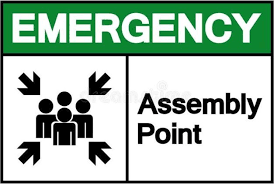Warehouses can be extremely busy and productive places of work, with large volumes of fast paced work being undertaken both manually and mechanically. An emergency can occur rapidly in such an environment. Many incidents that may occur are classed as foreseeable and as such you should perform thorough assessments addressing all the risks, no matter how minor, in your warehouse.
There are various safety challenges in a warehouse setup that escalate the risks in an emergency. Typically, a warehouse is a large and complex physical environment with a variety of equipment and vehicles. This impacts response times as people working in one section are not immediately aware of an incident in another area.
Evacuations can also be challenging.
The layout of the warehouse and location of emergency exits and equipment, including back-up power supplies, can be far apart. Often, warehouses store hazardous materials that increase the risks during emergencies. Just think of the location of your flammable stores and how their position may affect people’s safety during a fire outbreak. Include these factors in your planning and get the right emergency equipment to combat aggravating elements. Typically, large facilities need to prepare for more than one emergency. A warehouse, for example, requires specific fire extinguishers and spill kits to handle incidents.
In the UK, the Health and Safety at Work etc. Act (HASWA) 1974 and the Management of Health and Safety at Work Regulations 1999 deal with overall safety in any workplace. These laws state that employers must implement all reasonable and practical measures to keep work environments safe for employees and visitors.
There is also secondary, more specific legislation that deals directly with things such as fires and manual handling. Look at these regulations to ensure that your risk assessments include all possibilities and are safety compliant:
- Workplace (Health, Safety and Welfare) Regulations 1992.
- Manual Handling Operations Regulations 1992 (amended 2022).
- Regulatory Reform (Fire Safety) Order 2005.
- Reporting of Injuries, Diseases and Dangerous Occurrences Regulations (RIDDOR) 1995.
- Personal Protective Equipment at Work Regulations 1992.
- Control of Substances Hazardous to Health (COSHH) Regulations 2002.
- Provision and Use of Work Equipment Regulations (PUWER) 1998
- Control of Noise at Work Regulations 2005
Key responsibilities of fire wardens
You must appoint a fire warden for your warehouse. The fire warden performs proactive checking and reactive emergency duties and is your on-site ‘first responder’ during fire outbreaks. Proactive duties relate to safety measures to prevent fires. Depending on your warehouse setup, the number of employees, contents and equipment, these include ensuring that:
- Evacuation routes and emergency exits are obstruction-free.
- Emergency signage clearly marks routes and exit points.
- ‘Break glass’ call points and emergency fire action signs are visible.
- There are enough fire extinguishers for different types of fires and these are in working condition and stored properly.
- Combustibles, such as paper and waste, are effectively managed and not stored close to any ignition points.
- Flammable liquids and other hazardous materials are handled, stored and disposed of in line with COSHH guidelines.
- Fire alarms and equipment are tested regularly. This includes fire door checks.
- Fire emergency training of new and existing employees is carried out regularly.
- Fire risk assessments are carried out regularly and updated.
Reactive duties are those performed when a fire emergency occurs. These include:
- Using fire extinguishers.
- Raising fire alarms and calling emergency services.
- Overseeing evacuation procedures such as directing staff to emergency exits and gathering points.
- Sweeping all areas, including washrooms and walk-in cupboards, to ensure that all people got out.
- Assisting disabled people with equipment such as evacuation chairs.
- Closing windows, doors and fire doors.
- Isolating hazardous processes and machinery.
- Performing roll calls at assembly points.
- Reporting to the fire and rescue service.
Important points to be included in an emergency plan.
Special procedures are required for things such as serious injuries, explosions, floods, poisoning, electrocutions, fires, radioactivity, and chemical spills.
Risk assessments and emergency plans . You can’t develop an emergency plan without performing a careful risk assessment. By first evaluating all the potential risks, you can bolster your warehouse safety with an informed and relevant emergency plan. The HSE developed a short guide on warehousing and storage. It details important points in warehouse safety and the prevention of warehouse emergencies. Use it when assessing risks to broaden your scope. The law requires that you:
- Identify risks in your warehouse by walking around and noting activities that can cause harm or damage.
- Grade the severity of the different risks and involve union representatives and employees in these discussions.
- Track risky trends by reviewing past emergencies and problems.
- Eliminate the risk or, if this isn’t possible, control it.
A clear evacuation plan forms part of emergency planning and procedures. Consider the following when devising your escape plans:
- Effective use of emergency signage to mark emergency equipment, routes, exits and gathering points. When used correctly, signage, such as photoluminescent direction symbols, helps to speed up evacuations and curb injuries or fatalities.
- Equipment needed to safely evacuate your warehouse. Warehouse emergencies often require evacuation chairs to get people down ramps and stairs.
- PPE points containing items such as respirators and fire blankets to reduce smoke inhalation, burns and fire spreads.
Assessing risks and developing an emergency and evacuation plan are not ‘done-and-dusted’ tasks. Your warehouse environment changes constantly – think of expanding vehicle and storage capacities, for example. As such, it’s crucial to review your emergency procedures and update them as needed to cater for your specific environment.
Training and drills
As an employer, you have a legal duty to train employees for warehouse emergencies. You’ll often need different levels of training. For example, safety representative training will be different from the general drill training for employees. There’s also detailed instruction for those assigned to handle emergency equipment such as evacuation chairs and first aid apparatus such as AEDs and resuscitation equipment. When actual emergencies occur, employees should know what to do and where to go. Regular drills prepare employees for incidents and condition them to respond correctly during real-life warehouse emergencies. These practice drills familiarise your employees with the necessary safety steps in an emergency and form a core part of any health and safety procedures. The HSE’s pointers for a successful drill include:
- Devising mock scenarios relevant to your warehouse setup. For example, if you store and transport flammables, set up a drill that involves a realistic fire drill.
- Use your mock emergency drill to educate employees, contractors, and visitors. Involve as many people as possible to mimic real-life situations.
- Debrief your drill participants by focusing on what worked well and how to improve missteps. Here, you’ll gain valuable input and information to revise your warehouse emergency response plan.
It’s essential to be proactive rather than reactive when it comes to warehouse emergencies. A solid emergency and response plan that is relevant and up to date is the backbone of warehouse safety. Contact your Principal advisor for advice and support on the production of an effective warehouse emergency plan and procedure.











